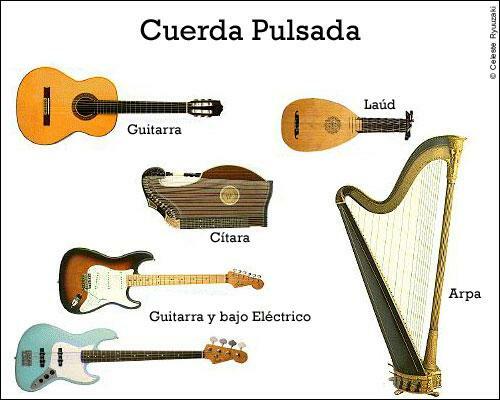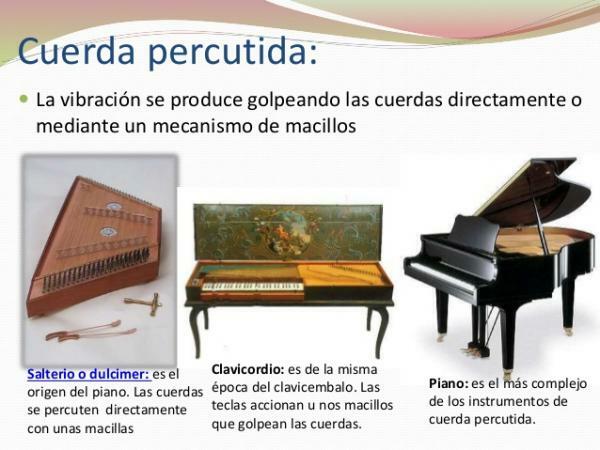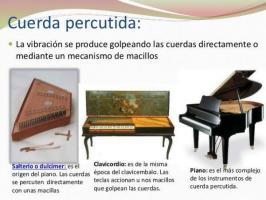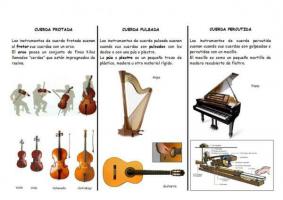LIST with the names of the STRING instruments and their CHARACTERISTICS

One of the most impressive gifts of the human being is art, the ability to take something mundane or merely physical and turn it into a means of expression through creativity. In the case of music, a natural element such as sound has been taken and instruments have been devised in various ways to shape this phenomenon. Percussion, wind, string... In this article by a TEACHER we will learn about the names of the stringed instruments.
Index
- The different types of instruments
- Characteristics of string instruments
- Rubbed string instruments
- Plucked string instruments
- Stringed instruments struck or percussed
The different types of instruments.
As we know, an instrument is a tool, an object designed to fulfill a goal. In the case of musical instruments, these objects are made to sound production. Depending on the desired sound, we must change the shape and mechanics of the instrument, to achieve a specific result.
There are several types of instruments
and all its physical characteristics influence the sound. Its general classification is through the technique by which we produce the sound. These groups are: Wind, percussion and string instruments. Next we will talk specifically about the names of string instruments and their characteristics.Characteristics of string instruments.
As their name implies, these are instruments that produce sound by means of strings, made of different materials (generally metal or nylon) that are held by the ends and tensioned to be pulsed or struck.
Apart from the material of the string, what makes the sound change in a stringed instrument is the length and thickness. Longer and thicker notes equate to lower frequency notes. Conversely, the shorter and thinner a string is, the higher-sounding notes it will produce.
One thing is the production of the sound only by the string, another thing is the space where this sound resonates, since that amplifies the sound. In general terms, this space where the sound bounces internally from the instrument is called "sounding board".
Although there are many string instruments, the important thing to classify them is still the technique by which the sound is produced. exist three general categories: rubbed string instruments, plucked string instruments and percussed string instruments.

Image: Musical strings
Rubbed string instruments.
They are those instruments where the friction of the strings with another material produces sound. They usually have a “bow”, a stick usually made of wood that has hair fibers, which is rubbed with tar (a product made from natural resin) to increase friction. Thanks to the technique of these instruments, it is very easy to produce long-lasting sounds.
The most popular instruments in this category are violin, viola, cello and double bass, listed in order from high to low range (the violin can produce the highest notes, the double bass the lowest). They all belong to the same family and their appearance is very similar, with size being the easiest way to identify them with the naked eye.
Another way to identify them by sight is the way to hold them. The violin and viola are played resting on the shoulder and lightly held by the chin. The cello or cello and the double bass are supported on the ground with the help of a metal rod. The cello player plays seated and the double bass player usually plays standing up or leaning slightly on a high chair.
As they belong to the same family and because of the warmth and versatility in the sound techniques of these instruments, they are par excellence the most solid base of a symphonic Orchestra. They also have the ability not only to serve as a harmonic base, but also to create sound effects or perform both romantic and virtuous melodies.
Outside the classical realm, these instruments have been used for fusions of popular musical genres, for folk styles as is the case with the violin, or for jazz, in the case of the double bass, which is mostly used as a plucked string instrument in this musical style.
Characteristics of the stringed instruments
- They have four strings that vary in thickness (sometimes they can have an additional string to look for more extreme sounds in tessitura).
- They are made of wood and have a resonance box, the sound enters through a pair of holes called "that" or "heard in efe" because its shape resembles those letters.
- They do not have junk on the neck (unlike instruments like the guitar).
- They require a "bow" to rub the strings and produce the lead sound.
- There are other techniques to produce other types of sounds such as "pizzicato", "Sul tasto""Harmonics" Y "tremolo" among other.
- Its way of tuning is by "Pegs"

Image: School Press
Plucked string instruments.
They are instruments with strings of which they are thrown and released immediately, using the fingertips or a plectrum (a small piece in the shape of a triangle). Like the stringed instruments, these usually have a soundboard, although not it is always necessary in electronic instruments (such as electric guitar) or by size, as in the case of harp.
The most popular instrument in this category is the guitar and its variants in style. It generally has 6 strings, frets to differentiate where to position your fingers on the neck, pegs for tuning the strings and soundboard or microphones (in the case of electric guitars).
Its shape is the same but its elements can change depending on the musical genre. Strings can change material. For example, the classical guitar has the first 3 nylon strings, while there are others for popular genres that use all metal strings. The quantity of the strings can also vary. There are guitars with 12 strings, which are actually arranged in pairs (that is, 6 pairs of strings, each string in a pair has the same assigned note). Another variant, although very rare, is the guitar with two necks.
Another popular plucked string instrument is the electric bass. At first glance it can be seen as a guitar but it is used for the lowest range, equivalent to the double bass. The strings of the electric bass are thicker and its neck is slightly longer than that of the guitar. Its main difference is that it usually has only 4 strings. Sometimes it can have more, if much lower notes are sought.
Finally we can mention the harp. The harp is also a plucked string instrument but it is quite different from the rest of the family. It is very large, has many more strings arranged from high to low, and has no frets. Each string has an assigned note that can only be altered by a pedal system, in case you want to use semitones. The harp does not have a sound box but its notes last for a long time thanks to its length. Another important factor is that it is played with both hands by plucking the strings, having the ability to create long chords like on the piano.
Curiosity: The clavecin It is an instrument with keys that can be confused with a stringed instrument because it resembles the harpsichord or a piano. However, the harpsichord mechanism does not strike the strings but rather strikes them, which is why it belongs to this category.
Other plucked string instruments: Banjo, mandolin, lute, balalaika, samishen.

Stringed instruments struck or percussed.
The strings in these instruments are struck, through a series of keys that actuate a mechanism that strikes the strings with a "hammer", a piece that is usually covered with a material made from pressed wool and leather.
In this family we find the piano, celesta and harpsichord. They all have keys with a note assigned to each, including semitones. Its extension can vary (some have more or fewer keys than others even in the same type of instrument). They also have a resonance box of different sizes. They are bulky instruments, with complicated mechanisms. Because of this and because of the complexity of their manufacture, they are usually the least economically and spatially accessible instruments. Fortunately today there are electronic and hybrid versions to replace these instruments, in cases of not being able to acquire a real one.
If you liked reading this article by a TEACHER about names of string instrumentsWe invite you to leave a comment and continue exploring the rest of the articles to continue learning.

Image: Slideshare
If you want to read more articles similar to Names of string instruments, we recommend that you enter our category of Musical instruments.


